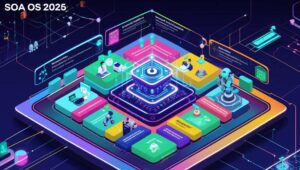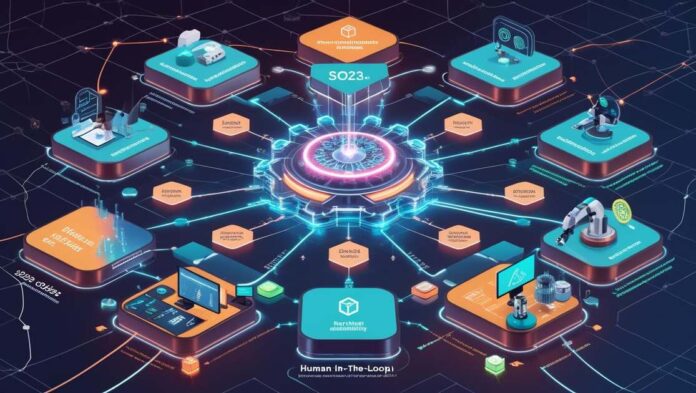Introduction: Why SOA OS23 Is the Future of Digital Systems
Today’s connected world digital ecosystems range beyond cloud-based applications to IoT devices on the edge, AI-powered applications, and workflows that involve humans. SOA OS23–short for Service-Oriented Architecture Operating Standards 2023 — is your solution to navigate the digital complexities through modularity, oversight and real-time ad hoc adaptability. If you’re a CTO DevOps engineer or enterprise engineer, SOA OS23 empowers you to create solutions that are not just flexible and compliant, but as well ethically and ethically.
1. What Is SOA OS23?
SOA OS23 isn’t an actual product, it’s an idea-driven framework that is also an open standard that was created to facilitate the design of deployment, orchestrating, and deploying services within a cloud-native microservices environment. It blends:
-
Traditional SOA legacy (reusable services and contracts)
-
Microservices’ flexibility (containerization and CD/CI)
-
Cloud-native infrastructure (Kubernetes, service mesh)
2. Pillars of SOA OS23 Architecture
2.1 Modularity & Intent-Driven Design
Services are highly granular, self-documenting capable of testing, versioning, and continuous updates, without having to restart the system.
2.2 Event-Driven Micro-Interactions
In contrast to static API calls to services, they create and respond to events, forming an asynchronous, living system
2.3 Semantic Interoperability
AI-based layers can translate not just semantics but also meaning across data models, thereby promoting real interoperability
2.4 Context-Aware Service Mesh
Service routing is adapted based on the identity of the user, their device, area, and compliance regulations–making complex orchestration
2.5 Ethical AI & Compliance Embedding
Modules contain metadata about access, use retention AI fairness and auditing, which is built directly in service agreements .
2.6 Human-in-the-Loop Automation
Important workflows, such as healthcare or finance decisions take a break for human reviews, and balance AI speed and human judgment .
3. SOA OS23 vs. Legacy SOA & Microservices
| Feature | Legacy SOA | Microservices | SOA OS23 |
|---|---|---|---|
| Protocols | SOAP/WSDL | REST/gRPC | REST/gRPC/GraphQL & semantic contracts |
| Governance | Centralized ESB | Ad-hoc | Built-in, contract-first, ethical, observable |
| Observability | Limited | By sidecars | Full stack telemetry and AI-based anomaly detection |
| Scalability & Modularity | Updates with coarse-grained granules | Container-centric | Modular services + microkernel orchestration |
| Security Model | Perimeter-based | Basic IAM | Zero-Trust, context-aware and mesh with an identity-aware feature |
4. Key Features & Benefits

-
Cloud-Native & Container Ready
Built for Docker, Kubernetes, serverless–compatible with DevOps pipelines . -
AI-Driven Orchestration & Observability
Predictive scaling and anomaly detection reduce downtime and manual toil -
Zero-Trust Security By Default
Automatic MTLS JWT/OAuth2, access control integrated into. -
Semantic Contracts & Governance
OpenAPI/AsyncAPI-first development with built-in ethical metadata -
Compatible with Legacy Systems
Bridges SOAP COBOL, old systems through protocol adapters
5. Use Cases by Industry
Healthcare
EHR, AI diagnostics, and remote monitoring systems are able to share information seamlessly, with human approval and the GDPR/HIPAA regulations.
Finance
In-real-time fraud detection, context-aware routing and low-latency trading pipelines that have ethical oversight as well as abnormal feedback.
IoT & Edge
Lightweight edge devices can scale services in accordance with latency as well as conformance requirements using embedded meta-control.
Manufacturing
Automated testing, robotics orchestration, live telemetry, as well as predictive maintenance – all with auditability as well as versions.
6. Adoption Challenges
-
Skills gaps require knowledge of AI ethics Service meshes, semantic engineering.
-
Operational Setting Up requires new pipelines for governance as well as traceability of compliance.
-
Ecosystem migration running on microkernels that are not POSIX-compatible or container-less creates more an additional layer of complexity.
7. Adoption Roadmap
-
Pilot Start
Containerize the service and establish metadata contracts (OpenAPI and ethics) and test triggers for events. -
Infrastructure Installation
Deploy registry of services as well as event broker, mesh engine and an observability stack (OpenTelemetry). -
Governance and Compliance
Train Ethics Engineers release audit metadata and integrate them with security and legal teams. -
Expand and Scale
Expand for edge deployments, AI-infused services with real-time human-in the-loop supervision.
8. Data-Driven Insights & Metrics
-
Reduced latency 30 percent using contextual-driven routing
-
The speed of detection for fraud in financial pilots: 4s to 700ms for Financial pilots
-
Migration ROI: 35% lower transaction handling time vs OS22
-
False positives in fraud Reduction of 92%
Placeholder Chart: “Response Time vs Architecture Type”
Placeholder Graphic: “SOA OS23 Component Stack”
9. Demand to Action Start with SOA OS23

To get a head start for 2025:
-
Get the Whitepaper: “SOA OS23: Building Ethical, Scalable Architectures” with the migration checklist as well as cases study.
-
Request a Consultation Free of Charge Check your structure’s ability to support SOA OS23 transition.
Aspect Details Title What Is SOA OS23? A New Standard for Modern Service Systems Overview SOA OS23 is a brand new Standardized framework developed to increase efficiency, interoperability, and scalability. effectiveness in the modern architecture of services-oriented architectures (SOA). Purpose A comprehensive system that simplifies integration of services and management across a variety of systems. Key Features A flexible and modular designBetter connectivity
Security protocols that are enhanced
Support for cloud and hybrid environmentsBenefits – Facilitates system integration
• Increases the agility and responsiveness
– Lowers the cost and complexity
– Facilitates digital transformation effortsTechnology Focus – Orchestration and composition of service
– Data exchange standard
– Frameworks for security and compliance
Compatible with both existing technology and new technologyImpact on Industry – Promotes standardized service development
It accelerates innovation in digital services
– Supports flexible and scalable enterprise architecturesChallenges & Considerations – Complexity of adoption
– Compatibility with older systems
Security and Compliance
Skills development and training for the use of
Conclusion
SOA OS23 is much more than an acronym. It’s actually a guideline for designing solid, secure and efficient systems in an environment defined by regulation, AI and the increasing the complexity. It brings developer flexibility and safeguards for ethics, and future-proofing the systems to meet what’s coming.
Read more: Lilapalooza: Origin Story and Cultural Influence


